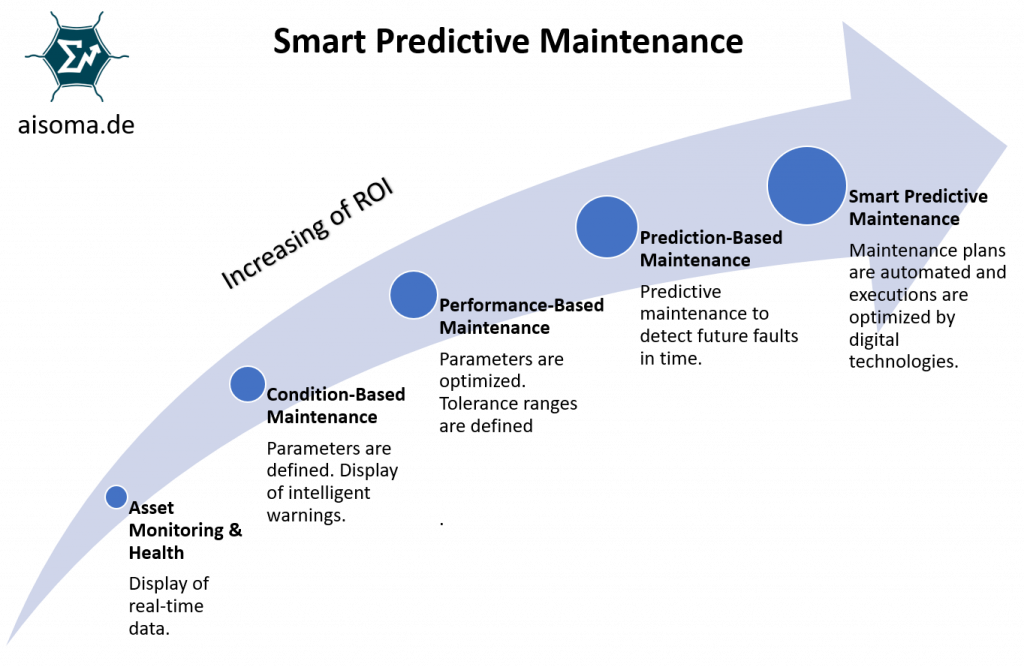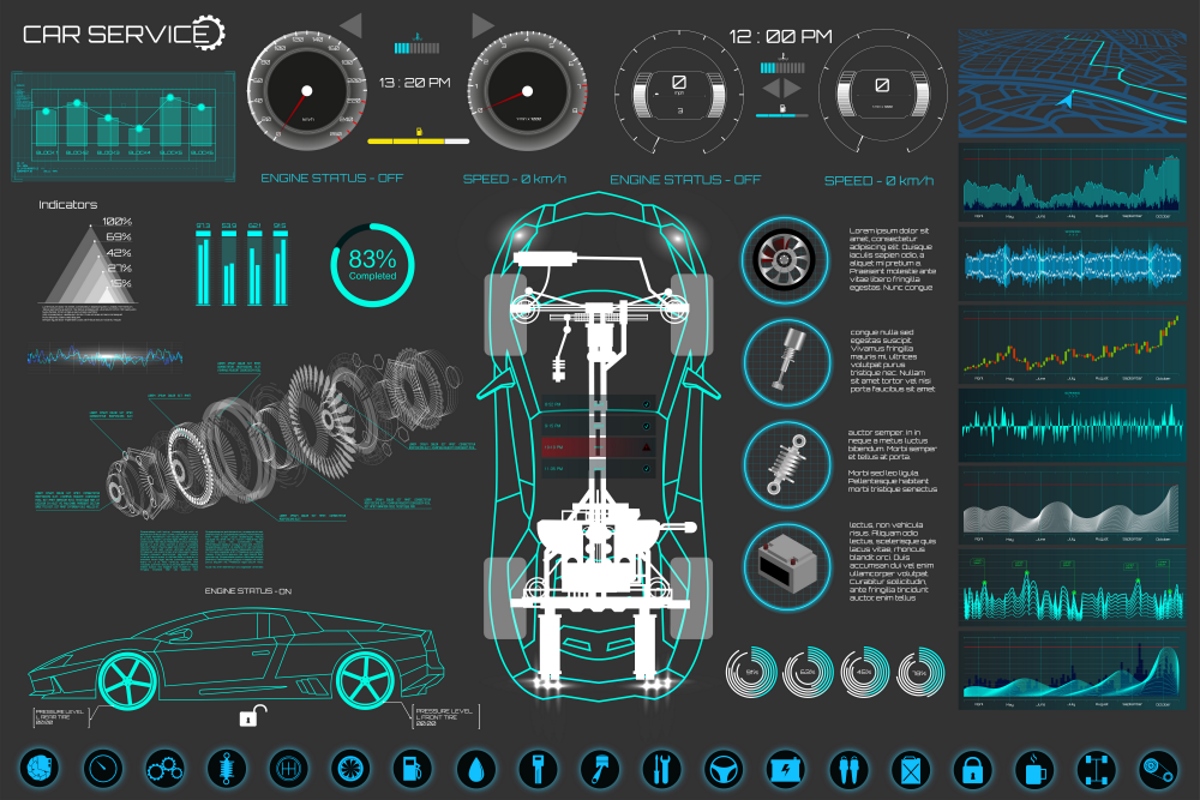Smart Predictive Maintenance is a modern maintenance technique that incorporates several technologies and maintenance approaches (including the powerful and advanced Predictive Maintenance (PdM) method).
[bctt tweet=”Smart Predictive Maintenance: The Key to Industry 4.0 #industry40 #IoT #IIoT #PredictiveMaintenance #Maintenance #Manufacturing #production #AI #ML #BigDataAnalytics #analytics ” username=”AISOMA_AG”]
SPdM is the continuous monitoring and analysis of a network of assets that enables prediction and notification of potential outages. Besides, it provides information on maintenance planning and spare parts planning, as well as automation of maintenance tasks.
Smart predictive maintenance goes beyond predictive maintenance (PdM) in three ways:
 1. SPdM monitors a network of assets connected via the Internet of Things (IoT). IoT is not just about sensors and actuators. The real value of IoT lies in the digital connections it creates. Digital information was not very useful before the invention of the Internet in the 1960s because it was all stored locally on individual computers and could not be shared remotely. The IoT connects information similar to the Internet, only that it is data from operational technologies (OT).
1. SPdM monitors a network of assets connected via the Internet of Things (IoT). IoT is not just about sensors and actuators. The real value of IoT lies in the digital connections it creates. Digital information was not very useful before the invention of the Internet in the 1960s because it was all stored locally on individual computers and could not be shared remotely. The IoT connects information similar to the Internet, only that it is data from operational technologies (OT).
When you network your assets, you can view the integrity of all assets in a single managed dashboard. Also, a network generates many more data points than individual machines. By combining OT network data, maintenance professionals can find patterns between machine failures and use a machine learning platform that can optimize or improve prediction algorithms over time.
 2. SPdM can automate some maintenance tasks. Predictive Maintenance (PdM) can predict potential machine failures. However, SPdM goes one step further and automates some maintenance tasks using cognitive data processing technologies. For example, if an inherent fault in an asset is detected, Smart Predictive Maintenance triggers a maintenance order, assigns a technician to it and schedules a ticket in a Computerized Maintenance Managed System (CMMS). Next, SPdM could check the spare parts inventory needed to replace the faulty component in an ERP system and include it in the work order. If the relevant part does not exist, SPdM could create a purchase requisition in the ERP system that only needs to be approved by the procurement specialist.
2. SPdM can automate some maintenance tasks. Predictive Maintenance (PdM) can predict potential machine failures. However, SPdM goes one step further and automates some maintenance tasks using cognitive data processing technologies. For example, if an inherent fault in an asset is detected, Smart Predictive Maintenance triggers a maintenance order, assigns a technician to it and schedules a ticket in a Computerized Maintenance Managed System (CMMS). Next, SPdM could check the spare parts inventory needed to replace the faulty component in an ERP system and include it in the work order. If the relevant part does not exist, SPdM could create a purchase requisition in the ERP system that only needs to be approved by the procurement specialist.
 3. SPdM is integrated into other maintenance management systems. To automate specific tasks, the predictive maintenance platform should be incorporated into either the CMMS, ERP, or Manufacturing Execution System (MES). Traditional PdM can fail if it is not integrated into your daily maintenance procedures. By combining SPdM with other maintenance systems, you can develop both a sustainable platform for processes and the potential to automate maintenance processes over time.
3. SPdM is integrated into other maintenance management systems. To automate specific tasks, the predictive maintenance platform should be incorporated into either the CMMS, ERP, or Manufacturing Execution System (MES). Traditional PdM can fail if it is not integrated into your daily maintenance procedures. By combining SPdM with other maintenance systems, you can develop both a sustainable platform for processes and the potential to automate maintenance processes over time.
Five steps to Smart Predictive Maintenance
A pilot phase should typically take three to four months on a single production line or only one or two well-suited assets. It can initially cover the first two steps of Asset Monitoring & Health and Condition Monitoring. The reason you can’t generally go straight to predictive maintenance is that it will take some time to set up data collection processes. Most importantly, the asset must fail at least a few times or exceed the defined tolerance limit to apply algorithms to it effectively. The more often a machine fails over time, the better the predictions or models will become.

Five steps to Smart Predictive Maintenance
Once data is reliably captured, and an asset has provided enough error data, the error thresholds can be optimized. Then a data scientist experienced in statistical analysis can begin creating predictive models. Predictive maintenance can often increase machine availability and uptime by 20 to 30 percent. The more errors occur, the better a machine learning platform can monitor failure data and update algorithms. This increases the ability to forecast each failure with the aim of minimizing unplanned downtime. Setting up and developing such a platform can take some time, so it is essential to start early and focus on the most critical resources first.
Energy and space companies have been using PdM techniques for years and are likely to move towards SPdM soon. As described above, such a maintenance strategy can be the key to improving the throughput, efficiency, quality, and safety of a facility. At the same time, maintenance and spare parts inventory costs can be reduced. More importantly, the road to SPdM is a journey that begins with a small step. No matter where you are on your maintenance journey, we at AISOMA can support you with our experts. Talk to us.
[bctt tweet=”Smart Predictive Maintenance: The Key to Industry 4.0 #industry40 #IoT #IIoT #PredictiveMaintenance #Maintenance #Manufacturing #production #AI #ML #BigDataAnalytics #analytics ” username=”AISOMA_AG”]
Contact: info@aisoma.de
Your AISOMA Team
Further AISOMA readings:
